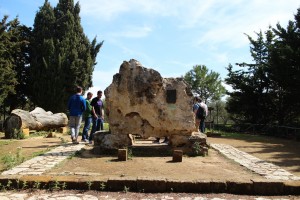The next day, we continued following writers through Italy. After visiting downtown Porto Empedocle to see traces of Montalbano and Camellieri, we drove to Agrigento to see Pirandello’s house. I loved looking at handwritten drafts of his writing and noting where he had edited the works we know today.
 One particularly good story, though, was that of his burial. Yet again, Italy makes a spectacle of itself and visitors get to enjoy its comical inefficacy. Pirandello had expressly written that he wished to have his body burned and his ashes scattered with no public funeral. The Sicilian writer died in Rome during Mussolini’s rule, and the fascist dictator capitalized on the opportunity to make a spectacle of this adored writer, giving him an elaborate funeral and burying his body in Rome.
One particularly good story, though, was that of his burial. Yet again, Italy makes a spectacle of itself and visitors get to enjoy its comical inefficacy. Pirandello had expressly written that he wished to have his body burned and his ashes scattered with no public funeral. The Sicilian writer died in Rome during Mussolini’s rule, and the fascist dictator capitalized on the opportunity to make a spectacle of this adored writer, giving him an elaborate funeral and burying his body in Rome.
Shortly after, his family pushed to have his ashes moved back to Sicily. Some American pilots agreed to fly them down in a helicopter and brought some Sicilians who needed to get back home along with them. Once the Sicilians found out about the contents of the mysterious box, containing Pirandello’s ashes in a Greek vase, they all asked to be let off because superstition told them it would be bad luck. Consequently, the pilots refused to fly the ashes back.
Next, someone took the ashes back by train, but he fell asleep, and a group of people took the box and used it to play cards. In any case, the ashes finally made it back to Agrigento and there was a small, local funeral and his ashes were buried (though there were complications with using the Greek vase as the priest wouldn’t bless it and it didn’t fit in the memorial). The story continues with a third funeral once his monument is finished fifteen years later, and ultimately the ashes of seven others are found inside of the vase and they’re finally scattered as he wished.